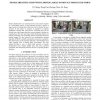Free Online Productivity Tools
i2Speak
i2Symbol
i2OCR
iTex2Img
iWeb2Print
iWeb2Shot
i2Type
iPdf2Split
iPdf2Merge
i2Bopomofo
i2Arabic
i2Style
i2Image
i2PDF
iLatex2Rtf
Sci2ools
ICMCS
2006
IEEE
2006
IEEE
People Identification with Limited Labels in Privacy-Protected Video
People identification is an essential task for video content analysis in a surveillance system. A good classifier, however, requires a large amount of training data, which may not be obtained in some scenario. In this paper, we propose an approach to augment insufficient training data with pairwise constraints that can be offered from video images that have removed people's identities by masking faces. We show user study results that human subjects can perform reasonably well in labeling pairwise constraints from face masked images. We also present a new discriminative learning algorithm WPKLR to handle uncertainties in pairwise constraints. The effectiveness of the proposed approach is demonstrated using video captured from a nursing home environment. The new method provides a way to obtain high accuracy of people identification from limited labeled data with noisy pairwise constraints, and meanwhile minimize the risk of exposing people's identities.
| Added | 11 Jun 2010 |
| Updated | 11 Jun 2010 |
| Type | Conference |
| Year | 2006 |
| Where | ICMCS |
| Authors | Yi Chang, Rong Yan, Datong Chen, Jie Yang |
Comments (0)

